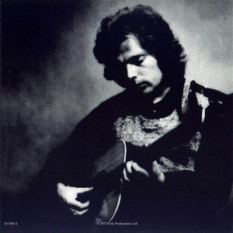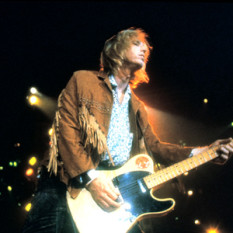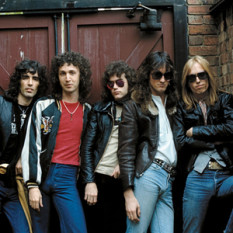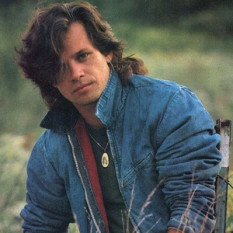Bruce Frederick Joseph Springsteen (born September 23, 1949 in Freehold, New Jersey, United States) is an American songwriter, singer, and guitarist. With a recording career stretching back to 1966 that continues to this day, he's recorded multiple award-winning studio albums and toured constantly, inspiring generations of pop and rock musicians. He's often known as "The Boss".
He has frequently played as Bruce Springsteen & The E Street Band. Most widely known for his brand of heartland rock infused with pop hooks, poetic lyrics, and Americana sentiments, he often sings songs centered around his native New Jersey. Initially inspired by the tuneful songwriting of British invasion music as well as the vocal swagger of Elvis Presley, his eloquence in expressing ordinary, everyday problems has earned him numerous awards, including twenty Grammy Awards and an Academy Award, along with a notoriously dedicated and devoted global fan base. He has sold over 70 million releases in the U.S. alone.
Springsteen's lyrics often concern men and women struggling to make ends meet. In this sense he was sometimes compared to Woody Guthrie and other popular folk artists. He has gradually become more and more identified with progressive politics, particularly working-class pride. Springsteen is also noted for his support of various relief and rebuilding efforts in New Jersey and elsewhere, and for his response to the September 11, 2001 attacks, on which his album The Rising reflects.
Springsteen's recordings have tended to alternate between commercially accessible rock and roll albums, often inspired by contemporary pop rock, and somber folk-oriented works. Much of his iconic status stems from the concerts and marathon shows in which he and the E Street Band present intense ballads, rousing anthems, and party rock and roll songs, among which Springsteen intersperses long, whimsical tales or deeply emotional stories alongside numerous jokes and asides.
Springsteen has long had the nickname "The Boss," a term which he was initially reported to dislike but now seems to have come to terms with, as he sometimes jokingly refers to himself as such on stage. The nickname originated when a young Springsteen, playing club gigs with a band in the 1960s, took on the task of collecting the band's nightly pay and distributing it amongst his bandmates.
Early years
Springsteen was born in a hospital in Long Branch, New Jersey. He was raised in nearby Freehold. His father, Douglas Frederick Springsteen, was a bus driver of Dutch and Irish ancestry. His mother, Adele Ann Zirilli, was a legal secretary of Italian ancestry. He has an older sister, Virginia, and a younger sister, Pamela. Pamela Springsteen had a brief film career, but left acting to pursue still photography full time.
Raised a Roman Catholic, Springsteen attended the St. Rose of Lima parochial school in Freehold Borough, where he was at odds with both the nuns and other students, even though much of his later music reflected a deep Catholic ethos and included many rock-influenced, traditional Irish-Catholic hymns.
In ninth grade he transferred to the public Freehold High School, but did not fit in there either. He completed high school but felt so uncomfortable that he skipped his own graduation ceremony. He briefly attended Ocean County College, but dropped out. It is rumored that the Dean of Students confronted Springsteen because his clothing made the other students "uncomfortable."
Springsteen had been inspired to take up music at the age of seven after seeing Elvis Presley on The Ed Sullivan Show. At 13, he bought his first guitar for $18; later, his mother took out a loan to buy the 16-year-old Springsteen a $60 Kent guitar, an event he later memorialized in his song "The Wish".
In 1965, he went to the house of Tex and Marion Vinyard, who sponsored young bands in town. They helped him become the lead guitarist of The Castiles, and later lead singer of the group. The Castiles recorded two original songs at a public recording studio in Brick Township, New Jersey and played a variety of venues, including Cafe Wha? in Greenwich Village. Marion Vinyard said that she believed Springsteen when, as a young man, he said he was going to make it big.
From 1969 through early 1971, Springsteen performed around New Jersey with guitarist Steve Van Zandt, organist Danny Federici and drummer Vini Lopez in a band called Child, later renamed Steel Mill. They went on to play the mid-Atlantic college circuit, and also briefly in California. During this time Springsteen also performed regularly at small clubs in Asbury Park and along the Jersey Shore, quickly gathering a cult following. Other acts followed over the next two years, as Springsteen sought to shape a unique and genuine musical and songwriting style: Dr Zoom & the Sonic Boom (early-mid 1971), Sundance Blues Band (mid 1971), and The Bruce Springsteen Band (mid 1971-mid 1972). With the addition of pianist David Sancious, the core of what would later become the E Street Band was formed, with occasional temporary additions such as horns sections, "The Zoomettes" (a group of female backing vocalists for "Dr Zoom") and Southside Johnny Lyon on harmonica. Musical genres explored included blues, R&B, jazz, church music, early rock'n'roll, and soul. His profilic songwriting ability, with more words in some individual songs than other artists had in whole albums, brought his skill to the attention of several people who were about to change his life: new managers Mike Appel and Jim Cretecos, and legendary Columbia Records talent scout John Hammond, who, under Appel's pressure, auditioned Springsteen in May 1972.
Even after gaining international acclaim, Springsteen's New Jersey roots reverberated in his music, and he routinely praised "the great state of New Jersey" in his live shows. Drawing on his extensive local appeal, he routinely sold out consecutive nights in major New Jersey and Philadelphia venues and, much like the Grateful Dead, his song lists varied significantly from one night to the next. He also made many surprise appearances at The Stone Pony and other shore nightclubs over the years, becoming the foremost exponent of the Jersey Shore sound.
1972–1974
Springsteen signed a record deal with Columbia Records in 1972, with the help of John Hammond, who had signed Bob Dylan to the same record label a decade earlier. Springsteen brought many of his New Jersey-based colleagues into the studio with him, thus forming the E Street Band (although it would not be formally named as such for a couple more years). His debut album, Greetings from Asbury Park, N.J., released in January 1973, established him as a critical favorite, though sales were slow. Because of his lyrics-heavy, folk rock-rooted music exemplified on tracks like "Blinded by the Light" and "For You," as well as the Columbia and Hammond connections, critics initially compared Springsteen to Bob Dylan. "He sings with a freshness and urgency I haven't heard since I was rocked by 'Like a Rolling Stone'," wrote Crawdaddy magazine editor Peter Knobler in Springsteen's first interview/profile, in March, 1973. Crawdaddy "discovered" Springsteen in the rock press and was his earliest champion. Famed music critic Lester Bangs wrote in Creem, 1975, that when Springsteen's first album was released....."many of us dismissed it: he wrote like Bob Dylan and Van Morrison, sang like Van Morrison and Robbie Robertson, and led a band that sounded like Van Morrison's." The track "Spirit in the Night" especially showed Morrison's influence, while with "Lost in the Flood" Springsteen presented the first of his many portraits of Vietnam veterans.
In September 1973 his second album, The Wild, the Innocent & the E Street Shuffle was released, again to critical acclaim but no commercial success. Springsteen's songs became grander in form and scope, with the E Street Band providing a less folky, more R&B vibe and the lyrics often romanticizing teenage street life. "4th of July, Asbury Park (Sandy)" and "Incident on 57th Street" would become fan favorites, and the long, rousing "Rosalita (Come Out Tonight)" would rank among Springsteen's most beloved concert numbers.
In the May 22, 1974 issue of Boston's The Real Paper, music critic Jon Landau wrote after seeing a performance at the Harvard Square Theater, "I saw rock and roll future and its name is Bruce Springsteen. And on a night when I needed to feel young, he made me feel like I was hearing music for the very first time." Landau subsequently became Springsteen's manager and producer, helping to finish the epic new album, Born to Run. Given an enormous budget in a last-ditch effort at a commercially viable record, Springsteen became bogged down in the recording process while striving for a wall of sound production. But, fed by the release of an early mix of "Born to Run" to progressive rock radio, anticipation built toward the album's release.
1975–1981
On August 13, 1975, Springsteen and the E Street Band began a five-night, 10-show stand at New York's Bottom Line club; it attracted major media attention, was broadcast live on WNEW-FM, and convinced many skeptics that Springsteen was for real. (Decades later, Rolling Stone magazine would name the stand as one of the 50 Moments That Changed Rock and Roll.) With the release of Born to Run on August 25, 1975, Springsteen finally found success: while there were no real hit singles, "Born to Run", "Thunder Road", "Tenth Avenue Freeze-out" and "Jungleland" all received massive FM radio airplay and remain perennial favorites on many classic rock stations to this day. With its panoramic imagery, thundering production and desperate optimism, some fans consider this among the best rock and roll albums of all time and Springsteen's finest work. It established him as a sincere and dynamic rock and roll personality who spoke for and in the voice of a large part of the rock audience. To cap off the triumph, Springsteen appeared on the covers of both Time and Newsweek in the same week, on October 27 of that year. So great did the wave of publicity become that Springsteen eventually rebelled against it during his first venture overseas, tearing down promotional posters before a concert appearance in London.
A legal battle with former manager Mike Appel kept Springsteen out of the studio for over two years, during which time he kept The E Street Band together through extensive touring across the U.S. Despite the optimistic fervor with which he often performed, the new songs he was writing and often debuting on stage had taken a more somber tone than much of his previous work. Reaching settlement with Appel in 1977, Springsteen finally returned to the studio, and the subsequent sessions produced Darkness on the Edge of Town (1978). Musically, this album was a turning point of Springsteen's career. Gone were the rapid-fire lyrics, outsized characters and long, multi-part musical compositions of the first three albums; now the songs were leaner and more carefully drawn and began to reflect Springsteen's growing intellectual and political awareness. Some fans consider Darkness Springsteen's best and most consistent record; tracks such as "Badlands" and "The Promised Land" became concert staples for decades to come, while the track "Prove It All Night" received a significant amount of radio airplay (#33, Billboard Hot 100). Other fans would prefer the work of the adventurous early Springsteen. The cross-country 1978 tour to promote the album would become legendary for the intensity of its shows.
By the late 1970s, Springsteen had earned a reputation in the pop world as a songwriter whose material could provide hits for other bands. Manfred Mann's Earth Band had achieved a U.S. number one pop hit with a heavily rearranged version of Greetings' "Blinded by the Light" in early 1977. Patti Smith reached number 13 with her take on Springsteen's unreleased "Because the Night" (which Smith co-wrote) in 1978, while The Pointer Sisters hit number two in 1979 with Springsteen's also-unreleased "Fire".
In September 1979, Springsteen and the E Street Band joined the Musicians United for Safe Energy anti-nuclear power collective at Madison Square Garden for two nights, playing an abbreviated setlist while premiering two songs from his upcoming album. The subsequent No Nukes live album, as well as the following summer's No Nukes documentary film, represented the first official recordings and filmings of Springsteen's fabled live act, as well as Springsteen's first tentative dip into political involvement.
Springsteen continued to consolidate his thematic focus on working-class life with the double album The River in 1980, which finally yielded his first hit Top Ten single as a performer, "Hungry Heart", but also included an intentionally paradoxical range of material from good-time party rockers to emotionally intense ballads. The album sold well, and a long tour in 1980 and 1981 followed, featuring Springsteen's first extended playing of Europe and ending with a series of multi-night arena stands in major cities in the U.S.
1982–1989
Springsteen suddenly veered off the normal rock career course, following The River with the stark solo acoustic Nebraska in 1982. According to the Marsh biographies, Springsteen was in a depressed state when he wrote this material, and the result is a brutal depiction of American life. The title track on this album is about the murder spree of Charles Starkweather. The album actually started (according to Marsh) as a demo tape for new songs to be played with the E Street Band - but during the recording process, Springsteen and producer Landau realized they worked better as solo acoustic numbers; several attempts at re-recording the songs in a studio led them to realize that the original versions, recorded on a simple, low-tech four-track cassette deck in Springsteen's kitchen, were the best versions they were going to get.
While Nebraska did not sell especially well, it garnered widespread critical praise (including being named "Album of the Year" by Rolling Stone magazine's critics) and influenced later significant works by other major artists, including U2's album, The Joshua Tree. It helped inspire the musical genre known as lo-fi music, becoming a cult favorite among indie-rockers. Springsteen did not tour in conjunction with Nebraska's release.
Springsteen probably is best known for his album Born in the U.S.A. (1984), which sold 15 million copies in the U.S. alone and became one of the best-selling albums of all time with seven singles hitting the top 10, and the massively successful world tour that followed it. The title track was a bitter commentary on the treatment of Vietnam veterans, some of whom were Springsteen's friends and bandmates. The song was widely misinterpreted as jingoistic, and in connection with the 1984 presidential campaign became the subject of considerable folklore. Springsteen also turned down several million dollars offered by Chrysler Corporation for using the song in a car commercial. (In later years, Springsteen performed the song accompanied only with acoustic guitar to make the song's original meaning more explicitly clear. An acoustic version also appeared on Tracks, a later album.) "Dancing in the Dark" was the biggest of seven hit singles from Born in the U.S.A., peaking at No. 2 on the Billboard music charts. The music video for the song featured a young Courteney Cox dancing on stage with Springsteen, an appearance which helped kickstart the actress's career; a number of the videos for the album were made by noted film directors Brian De Palma or John Sayles.
During the Born in the U.S.A. Tour he met actress Julianne Phillips. They were married in Lake Oswego, Oregon, on May 13, 1985 surrounded by intense media attention. Opposites in background, their marriage was not to be long-lived. Springsteen's 1987 album Tunnel of Love described some of his unhappinesses in the relationship and during the subsequent Tunnel of Love Express tour, Springsteen took up with backup singer Patti Scialfa, as reported by many tabloids. Subsequently, Phillips and Springsteen filed for divorce in 1988. The divorce was finalized in 1989.
The Born in the U.S.A. period represented the height of Springsteen's visibility in popular culture and the broadest audience demographic he would ever reach (this was further helped by releasing Arthur Baker dance mixes of three of the singles). Live/1975–85, a five-record box set (also released on three cassettes or three CDs), was released near the end of 1986 and also became a huge success, selling 13 million units in the U.S. and becoming the first box set to debut at No. 1 on the U.S. album charts. It is one of the best selling live albums of all time. It summed up Springsteen's career to that point and displayed some of the elements that made his shows so powerful to his fans: the switching from mournful dirges to party rockers and back; the communal sense of purpose between artist and audience; the long, intense spoken passages before songs, including those describing Springsteen's difficult relationship with his father; and the instrumental prowess of the E Street Band, such as in the long coda to "Racing in the Street". Despite its popularity, some fans and critics felt the album's song selection could have been better. Springsteen concerts are the subjects of frequent bootleg recording and trading among fans.
After this commercial peak, Springsteen released the much more sedate and contemplative Tunnel of Love (1987), a mature reflection on the many faces of love found, lost and squandered, which only selectively used the E Street Band. It presaged the breakup of his first marriage, to Julianne Phillips. Reflecting the challenges of love in Brilliant Disguise, Springsteen sang:
I heard somebody call your name, from underneath our willow. I saw something tucked in shame, underneath your pillow. Well I've tried so hard baby, but I just can't see. What a woman like you is doing with me.
The subsequent Tunnel of Love Express tour shook up fans with changes to the stage layout, favorites dropped from the set list, and horn-based arrangements; during the European leg in 1988, Springsteen's relationship with E Street Band backup singer Patti Scialfa became public. Later in 1988, Springsteen headlined the truly worldwide Human Rights Now! tour for Amnesty International. In the fall of 1989, he dissolved the E Street Band, and he and Scialfa relocated to California.
1990s
Springsteen married Scialfa in 1991; they have three children Evan James (b. 1990), Jessica Rae (b.1991) and Sam Ryan (b.1994).
In 1992, after risking charges of "going Hollywood" by moving to Los Angeles (a radical move for someone so linked to the blue-collar life of the Jersey Shore) and working with session musicians, Springsteen released two albums at once. Human Touch and Lucky Town were even more introspective than any of his previous work. Also different about these albums was the confidence he displayed. As opposed to his first two albums, which dreamed of happiness, and his next four, which showed him growing to fear it, at points during the Lucky Town album, Springsteen actually claims happiness for himself.
Some E Street Band fans voiced (and continue to voice) a low opinion of these albums, (especially Human Touch), and did not follow the subsequent "Other Band" Tour. For other fans, however, who had only come to know Springsteen after the 1975 consolidation of the E Street Band, the "Other Band" Tour was an exciting opportunity to see Springsteen develop a working onstage relationship with a different group of musicians, and to see him explore the Asbury Park soul-and-gospel base in some of his classic material.
It was also during this tour that fans generally became aware of Springsteen using a teleprompter so as to not forget his ly...
All albums
You can find information through the best music search engine - Muzlan.top 😊All materials on request "Bruce Springsteen" are available on page Bruce Springsteen
Yes of course. You can listen tracks on the page Bruce Springsteen
Yes of course. You can download tracks on the page Bruce Springsteen
This page is found by queries: Bruce Springsteen all mp3, Bruce Springsteen remix, Bruce Springsteen track minus, Bruce Springsteen flac, Bruce Springsteen songs download




